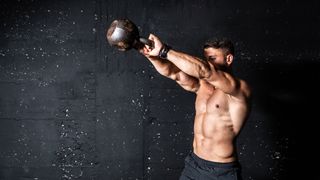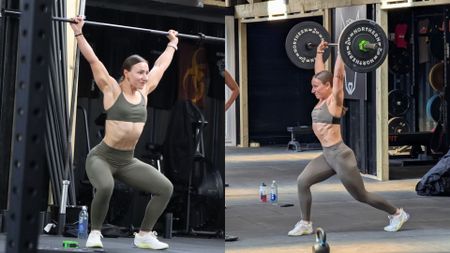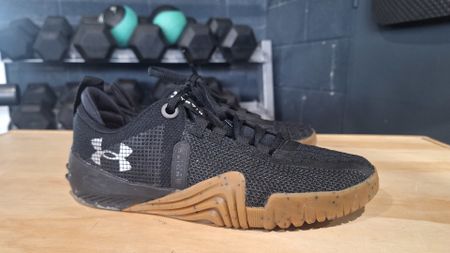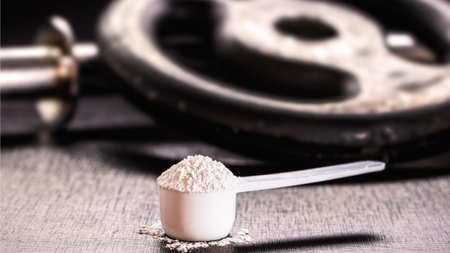

The 10,000 swing kettlebell workout challenge sounds promising, at least on paper: in only four weeks, it can 'reveal your six-pack' and 'increase grip strength and work capacity'. Can you get fit and lose belly fat using only the best kettlebells? Is four weeks enough to tone up and get a six-pack? Too good to be true? I tested the 10,000 swings kettlebell challenge to see if it delivers on its promise.
Being a fitness writer and a person interested in challenges, I volunteered to do the workout and dedicate four weeks to this kettlebell workout. At the end of the day, who wouldn't want a six-pack by swinging a metal orb with a handle for half an hour a day?
To make sure I followed through, I even roped in a few friends and family members who were interested in the 10,000 swings kettlebell challenge. As we all know, the best motivation is seeing others suffer through hours of gruelling workouts with you, am I right?
[PLEASE NOTE: This article was originally published in January 2021. It has been edited and updated since then.]
10,000-swing kettlebell challenge tested
What is it
The 10,000 swing kettlebell challenge is a month-long workout routine that uses only one kettlebell to enhance overall strength, help you lose weight and improve resilience. You do 500 kettlebell swings per workout, with some additional strength exercises in between. Each workout consists of five clusters of four sets of kettlebell swings. In each cluster, you perform 100 kettlebell swings in the following pattern:
- Set 1
- Kettlebell swing 10 reps
- Strength exercise 1 rep
- Set 2
- Kettlebell swing 15 reps
- Strength exercise 2 rep
- Set 3
- Kettlebell swing 25 reps
- Strength exercise 3 rep
- Set 4
- Kettlebell swing 50 reps
- Rest
Between the sets, you will be doing low-volume strength exercises, one of the following: overhead press, dip, goblet squat or chin up.
The original workout recommends a 30-60-second break after each round of 10, 15 and 25 kettlebell swings. After the set of 50, give yourself a 3-minute break and stretch to ease the muscles between clusters.
Sign up to the T3 newsletter for smarter living straight to your inbox
Get all the latest news, reviews, deals and buying guides on gorgeous tech, home and active products from the T3 experts
Work out for two days, rest for a day, then two days of work, then a day rest, and so on, until the end of the four weeks.
How I did it
To give you some background, I'm 6"1 and around 12 st 10 lbs (185 cm / 81 kg, respectively). I'm not a big guy by any means, and although I used a 24-kilo kettlebell for my kettlebell swings before, I wouldn't call myself a kettlebell specialist, either. That said, I work out almost daily; I usually do some resistance training and/or run/cycle.
During the 10,000 swing kettlebell challenge, you're required to pair the main movement – swings – with other kettlebell exercises. I chose only to do overhead presses, mainly because I wanted to build arm/shoulder definition and thought this 'push' exercise would compliment the swings, a 'pull' move.
Every beginning is hard

As expected, it was extremely tough to do the daily workouts, especially at the beginning. By the 300th swing on the first day, my forearms were on fire, and my will was dwindling – how would I be able to do 500 kettlebell swings five days a week for four weeks?
Even worse, I underestimated the strain on my core and managed to pull my back straight away on the first day. I did my swings with the 24-kilo kettlebell, and doing 500 swings plus 75 overhead presses in one day was too much for my lower back. By the end of the workout, I could tell there would be trouble the day after.
(Re)start

After giving myself a week to recover and reconsider my approach, I restarted the challenge with the 20 kg kettlebell. I opted to do kettlebell floor presses instead of overhead presses as a complimentary exercise. Lying on the floor in between the swings gave my lower back a much-needed break at the beginning.
It took me only two days to do the whole workout with the 24 kg kettlebell and a week to start doing overhead presses again. This was my first takeaway: you can't rush things. You must give your body time to adjust to the increased load, but it will get there quicker than you think.
A week later, after completing 3,500 swings, I wrote this in my workout diary: "Felt great improvements in grip strength, recovery time between sets and general endurance. I shaved off quite a lot of time compared to last time. Looking forward to seeing how the K/B press session will go (expecting some time savings there too). Had less than a 2-minute break after the first set."
One thing I noticed pretty early on was the improvement in my endurance. I needed less and less time between sets, and even when I did a different type of workout on rest days, they felt less demanding. It might have been only a mental block torn down, but the difference was very noticeable.

Needless to say, the workouts got shorter and less demanding as time went on. By the end of the challenge, I shaved off over ten minutes of my total workout time, and my grip was much better too. I also noticed the upper back and especially the traps – the muscles on the side of your neck – got more prominent by the end of the second week.
On the other hand, my abs were pretty much the same size, and I didn't lose much weight either. The kettlebell swing is praised for being a 'semi-cardio' exercise – it will burn plenty of calories and keep your heart rate in the 'fat burning zone'. However, notice that the claim was that the 10,000 swing kettlebell challenge would 'reveal' the abs, not build them.
You will use your abs to stabilise the swings, but it's not the same as actually working them with targeted exercises. Not to mention, following a strict diet is still essential to lose belly fat. This challenge can help people shift some body fat, but if you haven't got abs in the first place, doing the 10,000 swing kettlebell challenge won't help get them.
Verdict

Would I recommend doing the 10,000 swing kettlebell challenge? Not for people who are planning on building muscle and wish to do it in four weeks. If anything, I lost some of my push strength by the end of the challenge, and my pull strength was down, too.
However, I would recommend the challenge for people who work out often and would like to freshen up their training routine. Having four weeks off your usual workout pattern might provide enough variety for your body to get out of the progress rut you might find yourself in, and doing so many kettlebell swings will certainly build upper back muscles, which could improve posture.
Just make sure you go easy at the beginning.
Workout tips
- Go easy on the first week: Even if you have a bulletproof core, doing the same hip-hinge move will put a lot of pressure on the lower back.
- Be flexible: If you are feeling tired, have an extra rest day, even if it means you will finish the challenge a few days later than expected. Let your body regenerate in between workouts as much as possible.
- Don't count on others: I had two people starting the challenge with me, and none lasted longer than a few weeks. At the end of the day, you're doing this challenge for yourself, and the results are going to be yours only.
- Don't forget to stretch: do yoga or pilates on rest days and stretch between sets. I recommend the cat/cow pose, the baby pose, the child yoga poses and the dumbwaiter pilates move.
- Take notes: writing a workout diary can help you appreciate the effort and results even more. Jotting down how you felt after the workouts and possible ways to improve weaknesses can help you be more mindful about your workouts.

Matt Kollat is a journalist and content creator who works for T3.com and its magazine counterpart as an Active Editor. His areas of expertise include wearables, drones, fitness equipment, nutrition and outdoor gear. He joined T3 in 2019. His byline appears in several publications, including Techradar and Fit&Well, and more. Matt also collaborated with other content creators (e.g. Garage Gym Reviews) and judged many awards, such as the European Specialist Sports Nutrition Alliance's ESSNawards. When he isn't working out, running or cycling, you'll find him roaming the countryside and trying out new podcasting and content creation equipment.
-
 This PS5 Pro game proves the best part of next-gen isn't what you expected
This PS5 Pro game proves the best part of next-gen isn't what you expectedRay-traced reflections might be a mirage
By Max Freeman-Mills Published
-
 Oil pulling is going viral on TikTok for stopping morning breath – but does it actually work?
Oil pulling is going viral on TikTok for stopping morning breath – but does it actually work?4 hacks that prevent morning breath, according to a sleep expert
By Bethan Girdler-Maslen Published
-
 When’s the best time to take creatine?
When’s the best time to take creatine?The science-backed supplement is a must for building strength and muscle, but is there an optimal time to take it?
By Bryony Firth-Bernard Published
-
 Three overrated core exercises and what you should do instead
Three overrated core exercises and what you should do insteadA fitness expert says these exercises aren’t all they’re cracked up to be
By Bryony Firth-Bernard Published
-
 I tried Olympic weightlifting for the first time – here are three things it's taught me
I tried Olympic weightlifting for the first time – here are three things it's taught meBeing strong simply won't cut it
By Bryony Firth-Bernard Published
-
 Try these 7 standing Pilates exercises to build a more stable and stronger body
Try these 7 standing Pilates exercises to build a more stable and stronger bodyThis low-impact standing routine is ideal if you struggle with floor-based exercises
By Bryony Firth-Bernard Published
-
 An exercise scientist ranks every ab exercise – and the worst one may surprise you
An exercise scientist ranks every ab exercise – and the worst one may surprise youFYI it’s not crunches or sit-ups
By Bryony Firth-Bernard Published
-
 Skip the gym – this 20-minute standing dumbbell is low-impact and strengthens the entire body
Skip the gym – this 20-minute standing dumbbell is low-impact and strengthens the entire bodyIt's ideal if you have limited mobility too
By Bryony Firth-Bernard Published
-
 I didn't think Under Armour could improve its top-tier workout shoes – I was wrong
I didn't think Under Armour could improve its top-tier workout shoes – I was wrongThe TriBase Reign 6 has had a complete overhaul, with a flatter sole, improved flexibility and a brand-new look
By Bryony Firth-Bernard Published
-
 Creatine powder vs pills: which is better for muscle gains?
Creatine powder vs pills: which is better for muscle gains?A sports nutritionist gives the low-down on this popular supplement
By Bryony Firth-Bernard Published